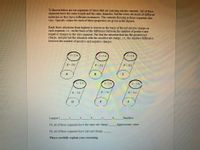
College Physics
11th Edition
ISBN: 9781305952300
Author: Raymond A. Serway, Chris Vuille
Publisher: Cengage Learning
expand_more
expand_more
format_list_bulleted
Question

Transcribed Image Text:7) Shown below are six segments of wires that are carrying electric currents. All of these
segments have the same length and the same diameter, but the wires are made of different
materials so they have different resistances. The currents flowing in these segments also
vary. Specific values for each of these properties are given in the figures.
Rank these situations from highest to lowest on the basis of the net electric charge on
each segment, i.e., on the basis of the difference between the number of positive and
negative charges in the wire segment. Put first the situation that has the greatest net
charge, and put last the situation with the smallest net charge, i.e., the smallest difference
between the number of positive and negative charges.
I-2 A
I-7 A
7-4 A
R-52
R=32
R 312
A
I-4 A
7= 3 A
1= 3 A
R = 52
R 72
R 32
Largest 1
2.
Smallest
Or, all of these segments have the same net charge,
Approximate value:
Or, all of these segments have zero net charge.
Please carefully explain your reasoning.
Expert Solution
This question has been solved!
Explore an expertly crafted, step-by-step solution for a thorough understanding of key concepts.
This is a popular solution
Trending nowThis is a popular solution!
Step by stepSolved in 2 steps

Knowledge Booster
Similar questions
- 7. Lightning discharges and lightning occur when charges are separated at different heights in the clouds, and lightning is a charge transfer with the ground where the voltage between cloud and ground is 1.0 MV. In a flash, the charge 1.0 C can be transferred during a time of 2.0 ms. (a) How many electrons correspond to the charge in such a flash? (b) Calculate the average current in the lightning. (c) What electrical power is developed in the lightning, and what is the energy? (d) If the cloud is at an altitude of 2.0 km, what is the electric field strength before the lightning and what is the force on an electron in the field?arrow_forwardGold is the most ductile of all metals. For example, 2 gram of gold can be drawn into a wire 2.4 km long. The density of gold is 19.3 x 103 kg/m3, and its resistivity is 2.44 x 10-8 Vm. What is the resistance of such a wire at 20.0°C? 2984 Ohms 1356 Ohms 1356250 Ohms 565Ohmsarrow_forwardconfused by chartsarrow_forward
- The wires shown are all made of the same material; the length and radius of each wire are noted. Rank in order, from largest to smallest, the resistances R1 to R5 of these wires. Explain.arrow_forwardDiscussion: Ohm's Law describes the relationship between the resistance (R) of a wire, the roltage drop across it (V), and current through it (D): V = RI (1) Applying a known current to a wire and measuring the voltage across it will lt you determine the resistance of the wire by solving equation 1: R =, (2) The resistance of a partieular element depends on its geometry, the resistivity and the temperature. Resistivity is the tendency of the material to behave as a resistor and is an inherent property of a material, in the same sense that density or thermal expansion are inherent properties. Materials with lower resistivity, like copper, are good conductors of electricity and widely used in eireuit components while those with larger resistivity, like rubber, are used as insulators. For a wire with length (L), cross-sectional area (A), and made from a material with resistiity (p) the resistance (R) will be given by the following equation: R= L (3) In case that the geometry (length and…arrow_forwardkenney works at an iron manufacturing plant. he make a piece of iron that has a resistivity of: 1.0 x 10-7-m this iron piece is in the shape of a truncated cone. help kenney calculate the resistance between the two circular ends of the cone. 2.00 cm 20.0 cm 4.00 cmarrow_forward
arrow_back_ios
arrow_forward_ios
Recommended textbooks for you
 College PhysicsPhysicsISBN:9781305952300Author:Raymond A. Serway, Chris VuillePublisher:Cengage Learning
College PhysicsPhysicsISBN:9781305952300Author:Raymond A. Serway, Chris VuillePublisher:Cengage Learning University Physics (14th Edition)PhysicsISBN:9780133969290Author:Hugh D. Young, Roger A. FreedmanPublisher:PEARSON
University Physics (14th Edition)PhysicsISBN:9780133969290Author:Hugh D. Young, Roger A. FreedmanPublisher:PEARSON Introduction To Quantum MechanicsPhysicsISBN:9781107189638Author:Griffiths, David J., Schroeter, Darrell F.Publisher:Cambridge University Press
Introduction To Quantum MechanicsPhysicsISBN:9781107189638Author:Griffiths, David J., Schroeter, Darrell F.Publisher:Cambridge University Press Physics for Scientists and EngineersPhysicsISBN:9781337553278Author:Raymond A. Serway, John W. JewettPublisher:Cengage Learning
Physics for Scientists and EngineersPhysicsISBN:9781337553278Author:Raymond A. Serway, John W. JewettPublisher:Cengage Learning Lecture- Tutorials for Introductory AstronomyPhysicsISBN:9780321820464Author:Edward E. Prather, Tim P. Slater, Jeff P. Adams, Gina BrissendenPublisher:Addison-Wesley
Lecture- Tutorials for Introductory AstronomyPhysicsISBN:9780321820464Author:Edward E. Prather, Tim P. Slater, Jeff P. Adams, Gina BrissendenPublisher:Addison-Wesley College Physics: A Strategic Approach (4th Editio...PhysicsISBN:9780134609034Author:Randall D. Knight (Professor Emeritus), Brian Jones, Stuart FieldPublisher:PEARSON
College Physics: A Strategic Approach (4th Editio...PhysicsISBN:9780134609034Author:Randall D. Knight (Professor Emeritus), Brian Jones, Stuart FieldPublisher:PEARSON

College Physics
Physics
ISBN:9781305952300
Author:Raymond A. Serway, Chris Vuille
Publisher:Cengage Learning

University Physics (14th Edition)
Physics
ISBN:9780133969290
Author:Hugh D. Young, Roger A. Freedman
Publisher:PEARSON

Introduction To Quantum Mechanics
Physics
ISBN:9781107189638
Author:Griffiths, David J., Schroeter, Darrell F.
Publisher:Cambridge University Press

Physics for Scientists and Engineers
Physics
ISBN:9781337553278
Author:Raymond A. Serway, John W. Jewett
Publisher:Cengage Learning

Lecture- Tutorials for Introductory Astronomy
Physics
ISBN:9780321820464
Author:Edward E. Prather, Tim P. Slater, Jeff P. Adams, Gina Brissenden
Publisher:Addison-Wesley

College Physics: A Strategic Approach (4th Editio...
Physics
ISBN:9780134609034
Author:Randall D. Knight (Professor Emeritus), Brian Jones, Stuart Field
Publisher:PEARSON